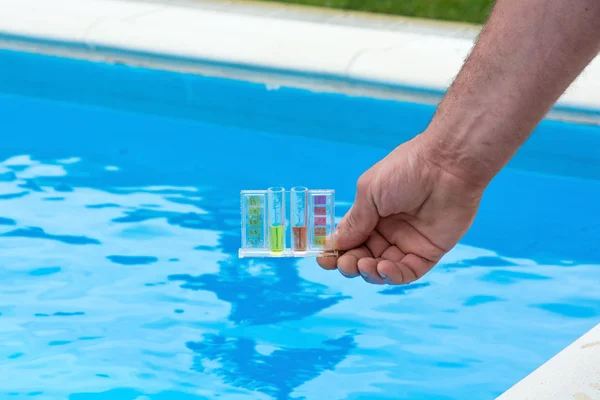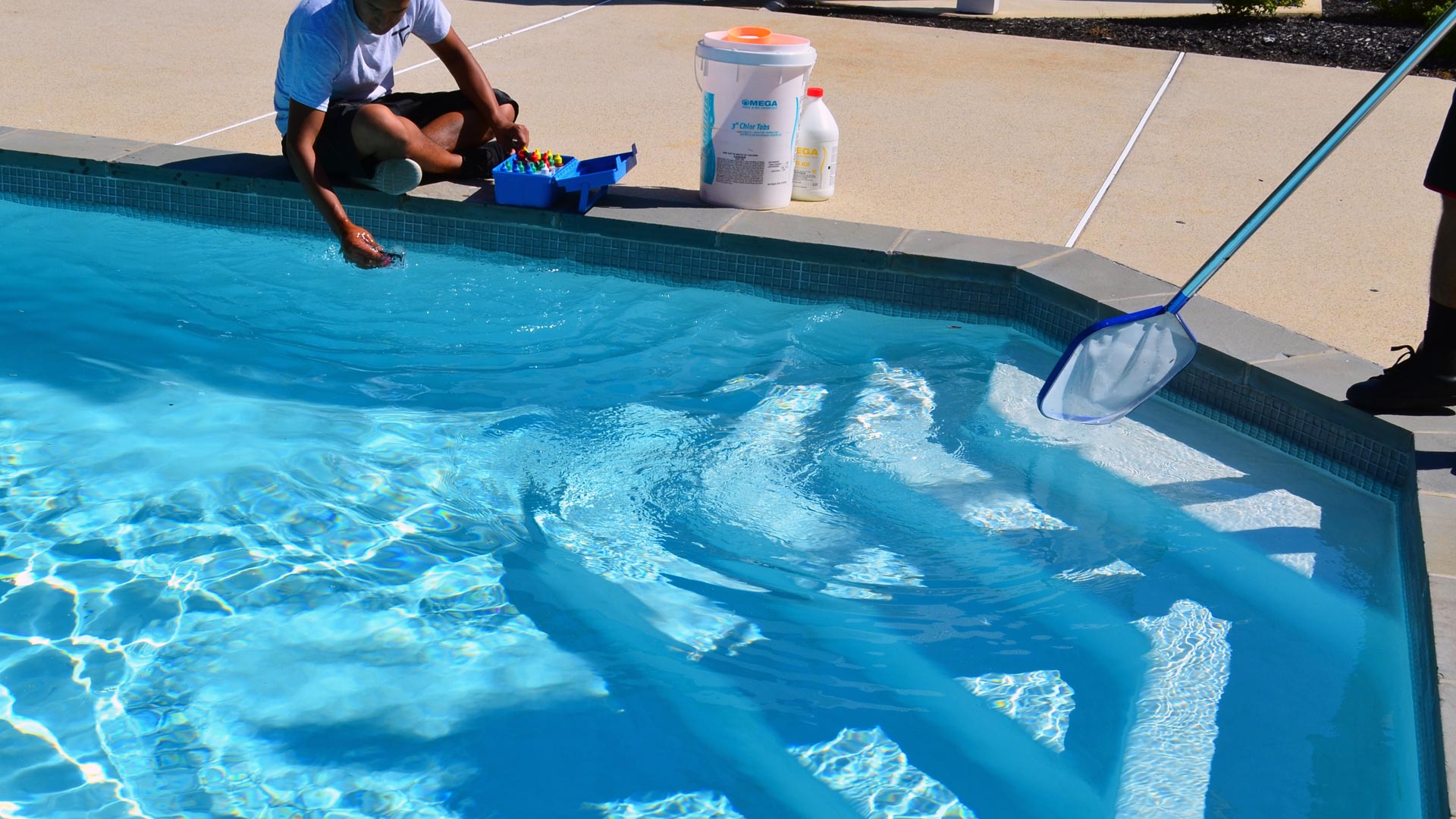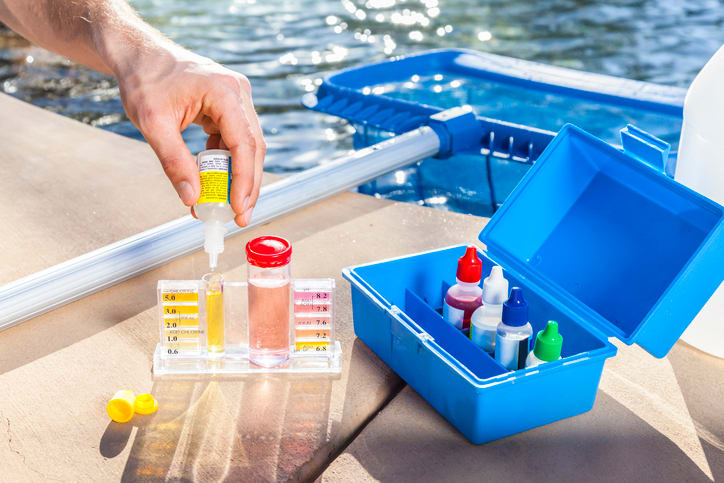Pool chemical maintenance can seem daunting to new pool owners, but with the right knowledge and approach, it becomes straightforward. This beginner’s guide covers the basics to help you keep your pool water clean, safe, and inviting.
Understanding Pool Chemistry
Learn the fundamentals of pool chemistry, including pH, chlorine, alkalinity, and calcium hardness. Understand their roles in maintaining water balance and clarity.
Importance of pH Balance
Discover why pH balance is crucial for water quality and bather comfort. Learn how to test pH levels and make adjustments to keep them within the ideal range.

Chlorine Management
Explore the significance of chlorine in sanitizing pool water. Learn different chlorine types, testing methods, and how to maintain proper chlorine levels.
Total Alkalinity
Understand total alkalinity and its role in stabilizing pH. Learn how to test and adjust alkalinity levels to prevent pH fluctuations.
Calcium Hardness
Discover the importance of calcium hardness in protecting pool surfaces. Learn how to test and adjust calcium levels to prevent scaling or corrosion.
Testing Procedures
Gain insights into testing procedures and frequency. Learn about test kits, strips, and electronic testers, and establish a testing routine.
Chemical Adjustments
Understand how to make chemical adjustments based on test results. Learn proper dosages and methods for adding chemicals to the pool.
Maintenance Tips
Explore maintenance tips for keeping your pool clean and healthy, including skimming, vacuuming, and filter maintenance.
Safety Precautions
Learn essential safety precautions when handling pool chemicals, including proper storage, protective gear, and avoiding chemical mixing.
Seeking Professional Help
Know when to seek professional assistance for complex chemical issues or if you’re unsure how to address specific water problems.
Oxidation Reduction Potential (ORP) Understanding
Understanding ORP can provide insight into the effectiveness of your pool’s sanitation. Learn how to measure and interpret ORP levels to ensure optimal disinfection and overall water quality.
Cyanuric Acid (CYA) Management Techniques
Discover the role of cyanuric acid in stabilizing chlorine levels and protecting chlorine from UV degradation. Learn how to monitor and adjust CYA levels to maintain proper chlorine effectiveness and water balance.
Shock Treatment Application Methods
Explore the benefits of shock treatment for oxidizing contaminants and restoring chlorine effectiveness after heavy pool usage or environmental stress. Learn when and how to perform shock treatments effectively to maintain water clarity and safety.

pH Drift Prevention Strategies
Discover proactive strategies for preventing pH drift, such as proper aeration techniques, regular testing, and avoiding chemical imbalances that can lead to pH fluctuations. Implementing these strategies can help maintain stable pH levels and optimize water quality.
Water Circulation Optimization Techniques
Understand the importance of proper water circulation in maintaining uniform chemical distribution and preventing stagnant areas where algae and bacteria can thrive. Learn how to optimize water circulation through pump settings, return jet positioning, and skimmer maintenance to ensure efficient filtration and chemical dispersion.
Seasonal Adjustments and Considerations
Learn how to adjust chemical parameters seasonally to account for factors like temperature changes, increased bather load during peak seasons, and weather conditions that may affect water balance. Implementing seasonal adjustments ensures that your pool chemistry remains stable and balanced throughout the year, promoting optimal water quality and swimmer comfort.
Algae Prevention Methods and Best Practices
Explore proactive measures for algae prevention, such as regular brushing, maintaining proper sanitizer levels, and using algaecides when necessary. Implementing these methods as part of your routine pool maintenance helps prevent algae growth and maintains water clarity, reducing the need for corrective treatments.
Importance of Filtration System Maintenance
Understand the critical role of the filtration system in removing debris and contaminants from the water to maintain water clarity and sanitation. Learn how to optimize filtration efficiency through regular filter maintenance, backwashing, and cleaning to ensure proper water circulation and filtration.
Balancing Chemical Interactions for Water Quality
Gain insights into how different pool chemicals interact with each other and how to balance these interactions to maintain water clarity, safety, and comfort. Understanding chemical interactions helps prevent adverse effects such as scaling, corrosion, or ineffective sanitation, ensuring that your pool water remains balanced and healthy for swimmers.
Monitoring Water Balance Trends for Long-Term Maintenance
Establish a system for tracking and analyzing water balance trends over time to identify patterns and make informed adjustments to your pool chemical maintenance routine. By monitoring trends in pH, chlorine levels, alkalinity, and other chemical parameters, you can proactively address issues and maintain optimal water quality and swimmer satisfaction.
Regular Backwashing and Filter Cleaning
Incorporate regular backwashing and cleaning of pool filters into your maintenance routine to ensure optimal filtration efficiency. Clean filters help remove debris and contaminants from the water, preventing them from recirculating and affecting water quality.
UV Protection Measures
Implement measures to protect your pool from UV degradation, such as using UV-resistant pool covers or adding UV inhibitors to the water. These measures help prevent chlorine degradation and maintain sanitizer effectiveness, especially in pools exposed to direct sunlight.

Proper Chemical Storage and Handling
Follow proper protocols for storing and handling pool chemicals to ensure safety and effectiveness. Store chemicals in a cool, dry, well-ventilated area away from direct sunlight and incompatible materials. Use appropriate protective gear and follow manufacturer instructions when handling chemicals to minimize risks and ensure accurate dosing.
Routine Water Testing and Analysis
Establish a routine schedule for water testing and analysis to monitor chemical levels and water quality parameters consistently. Regular testing allows you to identify any deviations from the desired range and take corrective action promptly, preventing water balance issues and maintaining optimal water quality.
Professional Maintenance and Inspection
Consider hiring a professional pool maintenance service for periodic inspections and maintenance tasks, such as equipment checks, chemical adjustments, and overall water quality assessment. Professional technicians have the expertise and specialized equipment to address complex issues and ensure your pool remains clean, safe, and properly balanced.
With this guide, you’re equipped with the knowledge and confidence to maintain your pool’s chemical balance effectively. By staying consistent with testing and adjustments, you’ll enjoy a safe and enjoyable swimming experience all season long.

